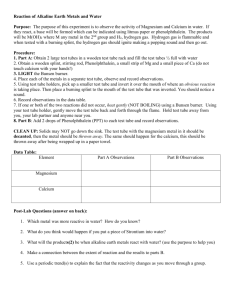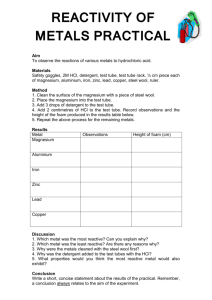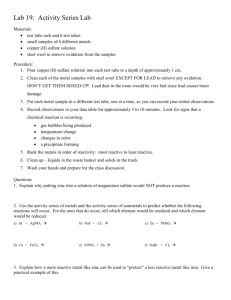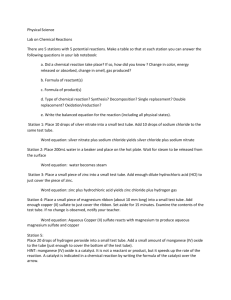Group 2 - Alkaline Earth Metals Lab
advertisement
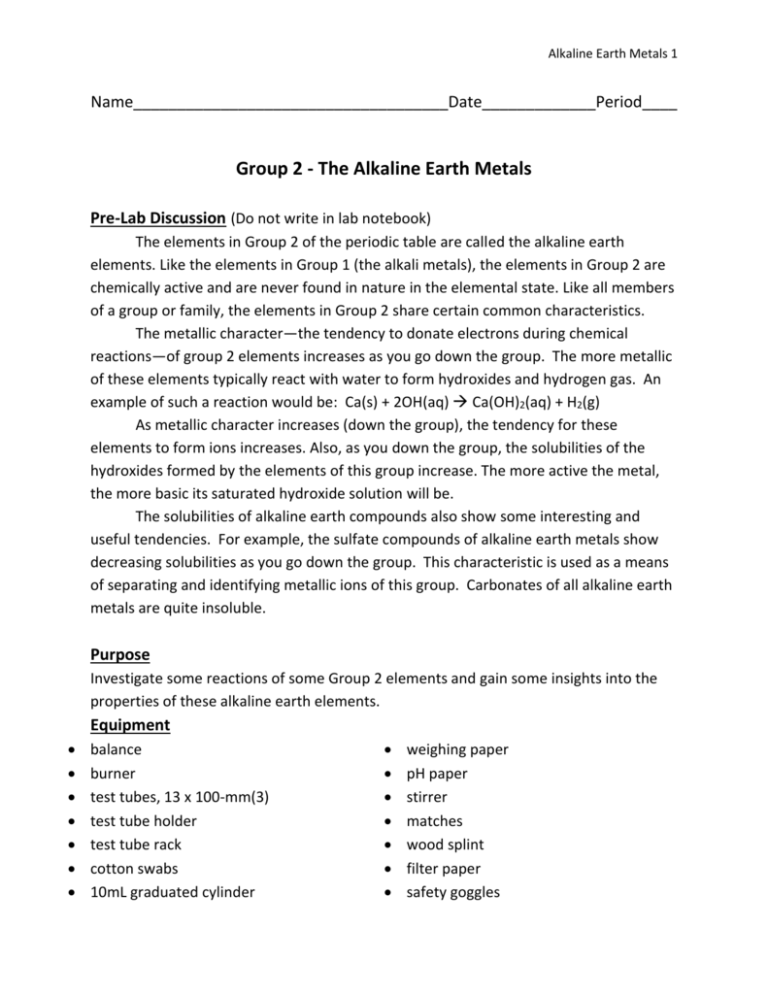
Alkaline Earth Metals 1 Name____________________________________Date_____________Period____ Group 2 - The Alkaline Earth Metals Pre-Lab Discussion (Do not write in lab notebook) The elements in Group 2 of the periodic table are called the alkaline earth elements. Like the elements in Group 1 (the alkali metals), the elements in Group 2 are chemically active and are never found in nature in the elemental state. Like all members of a group or family, the elements in Group 2 share certain common characteristics. The metallic character—the tendency to donate electrons during chemical reactions—of group 2 elements increases as you go down the group. The more metallic of these elements typically react with water to form hydroxides and hydrogen gas. An example of such a reaction would be: Ca(s) + 2OH(aq) Ca(OH)2(aq) + H2(g) As metallic character increases (down the group), the tendency for these elements to form ions increases. Also, as you down the group, the solubilities of the hydroxides formed by the elements of this group increase. The more active the metal, the more basic its saturated hydroxide solution will be. The solubilities of alkaline earth compounds also show some interesting and useful tendencies. For example, the sulfate compounds of alkaline earth metals show decreasing solubilities as you go down the group. This characteristic is used as a means of separating and identifying metallic ions of this group. Carbonates of all alkaline earth metals are quite insoluble. Purpose Investigate some reactions of some Group 2 elements and gain some insights into the properties of these alkaline earth elements. Equipment balance burner test tubes, 13 x 100-mm(3) test tube holder test tube rack cotton swabs 10mL graduated cylinder weighing paper pH paper stirrer matches wood splint filter paper safety goggles Alkaline Earth Metals 2 Materials calcium turnings (Ca) magnesium ribbon (Mg) magnesium sulfate crystals (MgSO4) calcium sulfate crystals (CaSO4) barium sulfate crystals (BaSO4) distilled water phenolphthalein solution saturated solutions of: o calcium hydroxide (Ca(OH)2) o magnesium hydroxide (Mg(OH)2) o barium hydroxide (Ba(OH)2) 0.1M solutions of: o Sodium carbonate (Na2CO3) o Magnesium chloride (MgCl2) o Calcium chloride (CaCl2) o Barium chloride (BaCl2) Procedure PART A 1. Pour about 5mL of distilled water into a clean, dry test tube and place the tube in the test tube rack. Add one calcium turning to the water in the test tube. To collect the gas being released, invert a clean, dry test tube over the reactant tube, holding the inverted test tube with a test holder. See below. 2. Test for hydrogen gas by inserting a burning wood splint into the upper part of the inverted tube. See below. 3. Add a few drops of phenolphthalein solution to the reactant tube. (Phenolphthalein is an acid-base indicator. It is clear in acid and bright pink in base.) Alkaline Earth Metals 3 4. Repeat step 1, using a 10-cm piece of magnesium ribbon in place of calcium. If no visible reaction occurs, heat the water to boiling, using a test tube holder to hold the tube over the burner flame. CAUTION: Point the tube away from yourself and others while heating. 5. Once the water is boiling, stand the tube in a test tube rack and, using a test tube holder, invert a collecting tube over the reactant tube. After a few seconds, test for hydrogen gas. 6. Turn off the burner and add a few drops of phenolphthalein to the reactant tube. Record your observations. PART B 7. Obtain 5-mL samples of saturated solutions of calcium hydroxide, magnesium hydroxide, and barium hydroxide. Test each solution with pH paper. Record the pH of each solution. PART C 8. Using the balance, measure out a 1-g sample of magnesium sulfate. Place it in a clean, dry test tube. 9. Repeat step 8 for calcium sulfate and barium sulfate. 10. Add 5mL of distilled water to each tube. Using a glass stirring rod, stir each mixture thoroughly, getting as much of each solid to dissolve as possible. Record your observations of the solubilities of each of these compounds. 11. Conduct a flame test for calcium ions (Ca2+) and for barium ions (Ba2+). Dip the cotton swab in water then into the calcium sulfate and place it in the flame. Repeat for barium sulfate using a new cotton swab. PART D 12. Stand 3 clean, dry test tubes in the test tube rack. Using 0.1M solutions, add about 5mL of the MgCl2 solution to one tube, 5mL of the CaCl2 solution to second tube, and 5mL of BaCl2 to the third tube. 13. To each of the solutions in the test tubes, add about 1mL of the Na2CO3 solution and record your observation. Alkaline Earth Metals 4 Observations and Data PART A Ca + HOH: Result of test for H2 gas __________________________________________________________________ Result of adding phenolphthalein __________________________________________________________________ Mg + HOH: Result of test for H2 gas (before heating) __________________________________________________________________ Result of test for H2 gas (After heating) __________________________________________________________________ Result of adding phenolphthalein __________________________________________________________________ PART B - pH Solution pH reading Magnesium hydroxide - Mg(OH)2 Calcium hydroxide - Ca(OH)2 Barium hydroxide – Ba(OH)2 PART C – Solubility and Flame Tests Solution Magnesium sulfate – MgSO4 Apparent Solubility Calcium sulfate – CaSO4 Barium sulfate – BaSO4 Ion Flame Test Results 2+ Calcium ion (Ca ) Barium ion (Ba2+) PART D – Adding Sodium Carbonate to Solutions Solution Observation after addition of Na2CO3 Magnesium chloride – MgCl2 Calcium chloride – CaCl2 Barium chloride – BaCl2 Alkaline Earth Metals 5 1. 2. 3. 4. Questions: Describe the reactivity of metals in Group 2 in terms of their location on the periodic table. How does the reactivity of an alkaline earth metal compare with that of an alkali metal (Group 1) in the same period? What oxidation states can the alkaline earth metals exhibit? Why does the metallic character of the alkaline earth metals increase as you move down the group? Conclusion: Write a paragraph containing the following information. Reference the experiment for each: Trend for reactivity within a group What does the phenolphthalein test tell you about the elements in the same group? Trend for pH within the group Trend for solubility within a group Flame tests for elements in the same group
